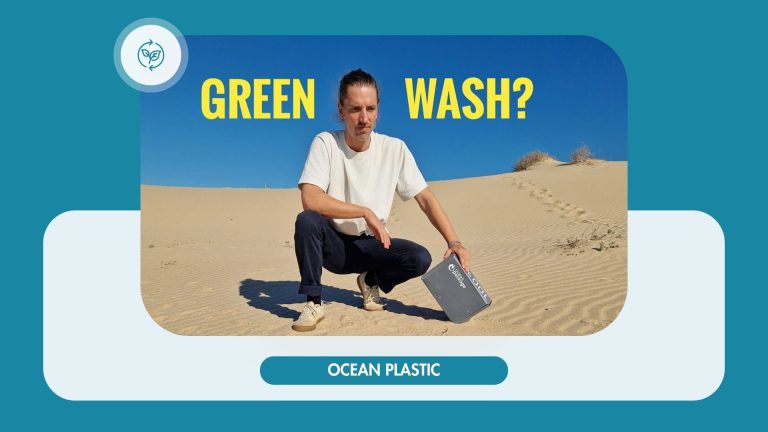
Plastic in the oceans kills marine life and destroys ecosystems—we’ve all seen the shocking images. It seems logical to produce and sell products made from ocean plastic. But is this a real solution, or are we falling into a greenwashing trap?
Reality Check: Ocean Plastic Recycling
Reality Check: Ocean Plastic Recycling
- Extent of Pollution: Every year, at least 1 million tons of plastic enter the ocean (1). Can cleanup efforts really counteract this? The majority of plastic sinks to the ocean floor or breaks down into microplastics, making recovery extremely difficult (2).
- Different Types of Plastic: There are many different types of plastic. Once plastic degrades, it often becomes impossible to determine its type. The chances of recycling it? Minimal. (3)
- Contamination: Plastic in the ocean not only becomes brittle due to saltwater and sunlight but also absorbs toxic chemicals and pollutants (5), further complicating its reuse.
Misleading Labels: The term “ocean plastic” is not regulated and can even refer to plastic collected from coastal areas (6). This reflects the challenge of recovering plastic directly from the ocean. Can a consistent supply of high-quality, usable plastic be ensured?
Check out our new reel!
Addressing Root Causes Instead of Risky Marketing Claims
Addressing Root Causes Instead of Risky Marketing Claims
Products made from ocean plastic can raise awareness, but they can also mislead consumers into believing that their purchases solve the problem. This creates a false sense of accomplishment and distracts from the urgent need to reduce plastic at its source.
To create a lasting solution, we must first tackle the root causes: plastic overproduction, single-use products, and poor waste management.
Simply producing goods from ocean plastic won’t save the oceans. When companies market these products as miracle solutions while ignoring the real issue, the alarm bells of greenwashing start ringing.
Key Takeaways at a Glance
Once plastic enters the ocean, recovering it becomes nearly impossible. While products made from ocean plastic can help raise awareness, they often border on greenwashing. Whether they truly contribute to saving the oceans or simply drive sales depends largely on how companies communicate their efforts.
The real solution lies in tackling the root causes. Let’s take decisive action against overproduction, single-use plastics, and inadequate waste management. Real change requires a circular economy—systemic measures and long-term solutions instead of short-term consumer strategies.
Sources:
(1) Meijer, L. J., Van Emmerik, T., Van Der Ent, R., Schmidt, C., & Lebreton, L. (2021). More than 1000 rivers account for 80% of global riverine plastic emissions into the ocean. Science Advances, 7(18), eaaz5803.
(2) García Rellán, A., Vázquez Ares, D., Vázquez Brea, C., Francisco López, A.,Bello Bugallo, P. (2023). Sources, sinks and transformations of plastics in our oceans: Review, management strategies and modelling.
(3) Ronkay, F., Molnar, B., Gere, D., Czigany, T., (2001) Plastic waste from marine environment: Demonstration of possible routes for recycling by different manufacturing technologies.
(5) https://www.fidra.org.uk/news/chemicals-and-plastic-exploring-the-toxic-tag-a-longs-to-nurdles/
(6) https://www.focus.de/earth/experten/warum-ozeanplastik-nur-selten-aus-dem-meer-kommt_id_194483813.html
Relevant content
From the Toilet into the Deep: Wet Wipes in the Ocean
The connection between our bathrooms and the sea is often...
Read MoreSocial Business: How Ocean Package is revolutionising the packaging industry (Munich Insights)
As Becci from The Ocean Package team, I am writing...
Read More
